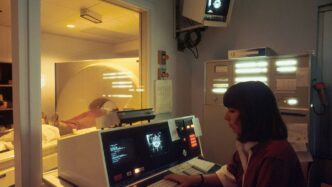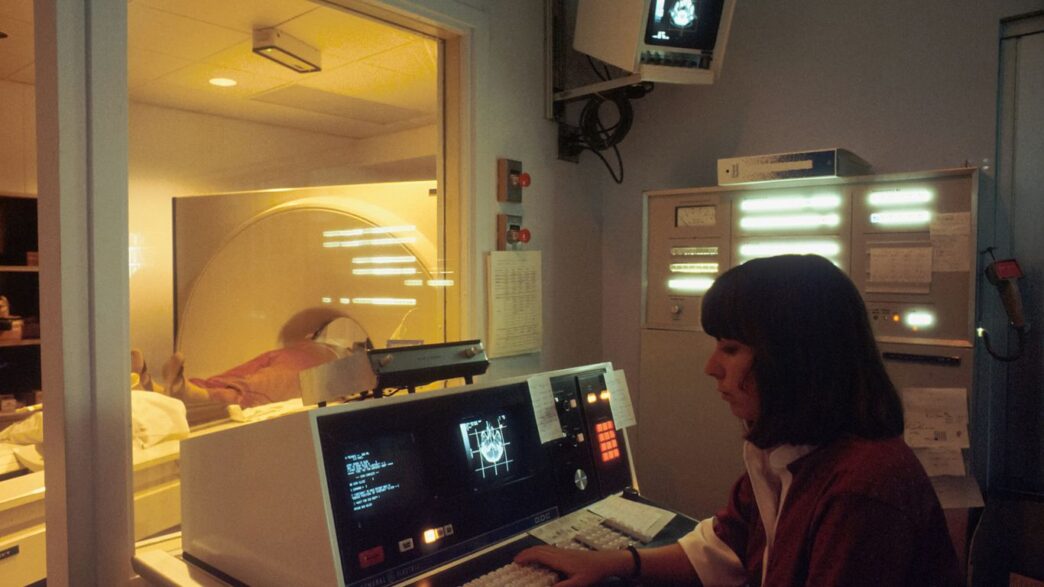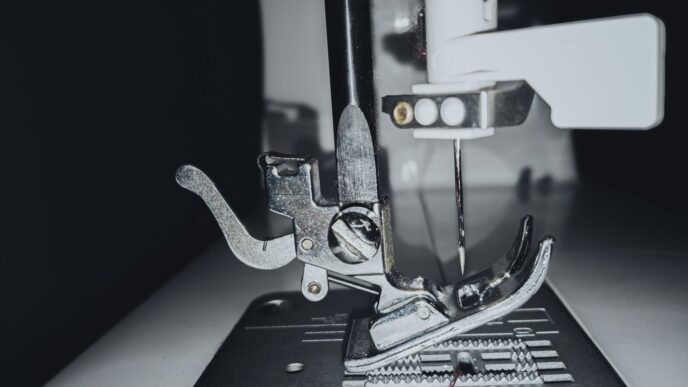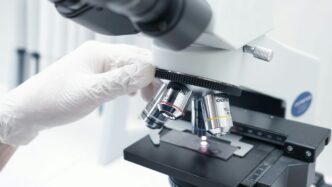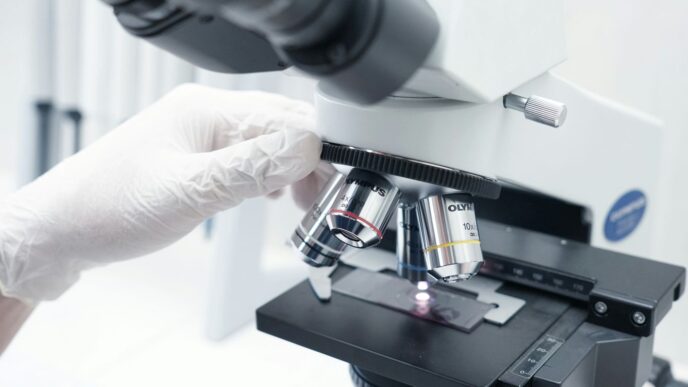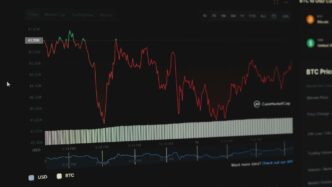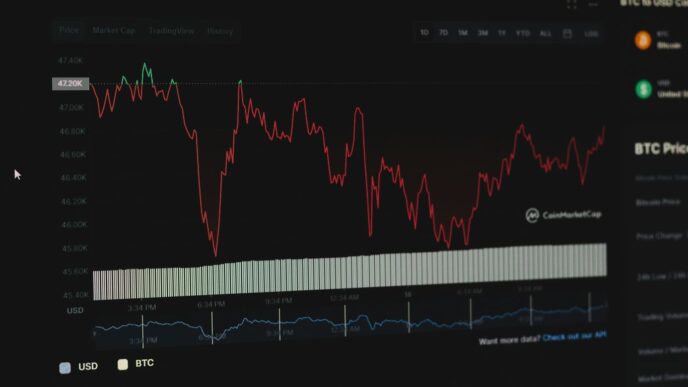Healthcare is changing, and fast. It feels like every time you turn around, there’s some new piece of medical technology that promises to make things better. We’re talking about stuff that can spot problems earlier, help doctors understand you as an individual, and even make treatments more effective. It’s not just in hospitals anymore either; some of this new medical technology is showing up in our homes and on our wrists. Let’s take a look at some of the big shifts happening in 2025.
Key Takeaways
- Artificial intelligence is getting really good at helping doctors figure out what’s wrong, from reading scans to predicting genetic risks.
- Healthcare is becoming more about you as an individual, using your own data to figure out the best way to keep you healthy.
- Wearable and implantable devices are becoming more common, offering new ways to track your health and even interact with technology.
- Faster internet (5G) and huge amounts of data are changing how healthcare is delivered, making things like remote surgery possible.
- New ways of making medical tools, like 3D printing, are creating custom solutions that fit patients better and improve treatments.
Artificial Intelligence Revolutionizing Diagnostics
Artificial intelligence is really changing how we figure out what’s wrong with people. It’s not just about making things faster, but also about spotting things that might be missed otherwise. Think of it like having a super-powered assistant for doctors.
AI-Powered Diagnostic Imaging Systems
These systems are a big deal. They use AI to look at medical scans like X-rays, CT scans, and MRIs. The AI can spot tiny details or patterns that might indicate a disease, sometimes even before a human eye can. This means earlier detection for things like cancer or other serious conditions. It’s like having an extra set of eyes that never get tired and can process images incredibly quickly.
- Faster analysis of scans: AI can go through hundreds of images in minutes.
- Improved accuracy: It helps reduce the chance of missing subtle signs of illness.
- Early disease detection: Catching problems sooner often leads to better outcomes.
AI is becoming a vital tool in radiology and pathology, helping to sift through vast amounts of visual data to pinpoint potential issues with remarkable speed and precision. This doesn’t replace the radiologist or pathologist, but rather augments their capabilities, allowing them to focus on complex cases and patient care.
AI Genetic Risk Prediction Tools
We’re also seeing AI get really good at looking at our genes. By analyzing genetic data, AI can help predict the likelihood of developing certain hereditary diseases. This is huge for preventive care. If we know someone has a higher risk for, say, a specific heart condition, doctors can recommend earlier or more frequent screenings, or even lifestyle changes to try and ward it off. It’s about getting ahead of potential health problems before they even start.
AI Administrative Copilots
Beyond the direct diagnosis, AI is also cleaning up the messy administrative side of healthcare. Doctors and nurses spend a lot of time on paperwork, charting, and dealing with insurance. AI "copilots" can help automate a lot of this. They can help draft notes, organize patient records, and even manage scheduling. This frees up valuable time for healthcare professionals to spend with patients, rather than buried in forms.
| Task | Traditional Time | AI Copilot Time | Time Saved |
|---|---|---|---|
| Charting patient visit | 15 minutes | 5 minutes | 10 minutes |
| Scheduling follow-ups | 10 minutes | 3 minutes | 7 minutes |
| Processing referrals | 20 minutes | 8 minutes | 12 minutes |
Personalized Medicine and Predictive Healthcare
Forget the one-size-fits-all approach to health; 2025 is all about you. Personalized medicine is really taking off, moving beyond just a buzzword to become a practical reality in how we manage our well-being. It’s about looking at your unique makeup – your genes, your lifestyle, even the environment you live in – to figure out the best way to keep you healthy or treat you if you get sick.
Precision Medicine’s Rise
This is where things get really interesting. Instead of a general treatment plan, doctors are now using your specific genetic information and other personal data to tailor treatments. Think of it like getting a custom suit versus buying one off the rack. This means more accurate diagnoses and treatments that actually work better for you. We’re seeing this in action with things like gene therapies for rare diseases, where treatments are designed to fix the root genetic cause, not just manage symptoms. It’s a huge shift from just treating the illness to addressing the underlying issue at a molecular level.
Digital Twin Technology for Patient Modeling
Imagine having a virtual copy of yourself, a "digital twin," that doctors can use to test treatments or predict how a disease might progress. This technology is becoming more sophisticated. For years, researchers have been building virtual models of organs like the heart. Now, major hospitals are starting to integrate these detailed 3D models, essentially digital twins, into their daily work. They can use them to plan complex surgeries or even study how different patient groups respond to treatments, helping to spot health disparities.
Prophylactic Procedures Based on Predisposition
Knowing you have a higher risk for certain conditions is one thing, but acting on it before anything happens is the real game-changer. AI is getting incredibly good at analyzing vast amounts of genetic data to predict your risk for over a thousand different diseases, sometimes years in advance. While it’s not yet standard practice everywhere, doctors are starting to use these predictions to recommend earlier or more frequent screenings for things like certain cancers or kidney issues. This proactive approach means you can make lifestyle changes or undergo preventive procedures to significantly lower your chances of developing a serious illness. It’s about staying ahead of the curve and taking control of your health future.
The move towards personalized and predictive healthcare isn’t just about fancy technology; it’s about making healthcare more effective and efficient by focusing on the individual. By understanding our unique biological makeup and potential risks, we can shift from reacting to illness to actively preventing it, leading to better health outcomes for everyone.
Advancements in Wearable and Implantable Medical Technology
It feels like just yesterday we were marveling at the first smartwatches that could track our steps. Now, the world of wearable and implantable tech is really stepping up its game, moving beyond simple fitness tracking into some pretty serious medical territory. These devices are becoming sophisticated health monitors, offering insights that were once only available in a doctor’s office.
Wearable Diagnostic Devices
Forget just counting calories. We’re seeing wearables that can actually detect medical conditions. Think smartwatches with ECG capabilities that can flag irregular heart rhythms, like atrial fibrillation. Hospitals are even starting to use the data streams from these devices to keep tabs on patients after they’ve gone home. There are also patches that monitor sweat for things like electrolyte balance and hydration levels – super useful for athletes, sure, but also for people working in tough conditions or recovering from illness. The goal here is to catch potential problems early, sometimes even before you notice anything’s wrong, and to help doctors make better decisions about your care.
Here’s a quick look at what’s becoming more common:
- ECG-enabled smartwatches: For spotting heart rhythm issues early.
- Continuous glucose monitors (CGMs): Often in the form of contact lenses or small patches, these help people manage diabetes without constant finger pricks.
- Hydration and electrolyte trackers: Useful for athletes and those at risk of dehydration.
- Advanced sleep trackers: Going beyond just duration to analyze sleep stages and potential sleep disorders.
The integration of these devices into the broader healthcare system, often called the Internet of Medical Things (IoMT), means that real-time health data can be shared directly with healthcare providers. This allows for more proactive interventions and can help reduce the need for some in-person visits.
Brain-Computer Interfaces and Implants
This is where things get really futuristic, but it’s happening. Brain-Computer Interfaces (BCIs) and other implantable devices are starting to show real promise. While the idea of brain chips might sound like science fiction, these technologies are being developed to help people with serious conditions. We’re talking about potential applications for managing chronic pain, controlling prosthetic limbs with thought, or even helping individuals with paralysis regain some movement. It’s still early days for widespread use, and there are definitely ethical questions to consider, like who owns the data your brain generates, but the potential to improve lives is huge.
Smart Implants Emerging Healthcare Trends
Beyond BCIs, there’s a whole category of "smart" implants that are becoming more accessible. These aren’t just passive devices anymore. Think about implants that can release medication precisely when needed, or devices that help with rehabilitation after surgery or injury. The advancements in materials and manufacturing, including 3D printing, are making these implants more personalized and effective. They’re designed to integrate better with the body, last longer, and offer improved functionality, whether it’s a new joint, a spinal support, or even something more complex. The aim is to make recovery smoother and to address disabilities in ways we couldn’t before.
The Impact of 5G and Big Data on Healthcare Delivery
It’s pretty wild how much things are changing in healthcare, especially with 5G and all the data we’re collecting. These aren’t just buzzwords anymore; they’re actually making a difference in how we get care and how doctors can help us. Think about it: the speed of 5G is way faster than what we had before, and the amount of information we can now analyze is just huge.
5G-Enabled Medical Devices
This is where things get really interesting. Because 5G is so fast and responsive, we’re seeing a whole new wave of medical gadgets that can send information almost instantly. This means things like remote monitoring of patients at home can be much more reliable. Doctors can get real-time updates on vital signs, and if something looks off, they can step in much quicker. It’s like having a constant, high-speed connection to your health.
- Faster Data Transmission: Devices can send large amounts of data, like high-definition video from a remote surgery or continuous heart readings, without delay.
- Improved Remote Care: Patients in rural areas or those with mobility issues can receive more consistent and immediate attention.
- Real-time Diagnostics: Portable devices can transmit findings to specialists instantly, speeding up diagnosis.
Big Data and Analytics for Disease Prevention
We’re generating an unbelievable amount of health information these days, from doctor visits to wearable fitness trackers. When we can sort through all this information – and keep it private, of course – we start to see patterns. These patterns can help us figure out how diseases spread, who might be at higher risk for certain conditions, and how we can stop problems before they even start. It’s like having a super-smart detective looking at all the clues to keep us healthier.
Analyzing massive datasets allows researchers and healthcare providers to identify trends, predict outbreaks, and develop more targeted prevention strategies. This data-driven approach moves us away from just reacting to illness and towards proactively managing public and individual health.
Remote Robotic Surgery Systems
This one sounds like science fiction, but it’s becoming a reality. With 5G’s low delay and high speed, surgeons can control robotic arms from miles away. They get live video feeds and can perform complex procedures with incredible precision. This means that someone needing a specialized surgery might not have to travel far to see the best doctor; the best doctor can come to them, virtually speaking.
Here’s a quick look at how it works:
- Surgeon’s Control Station: The surgeon operates controls that manipulate robotic instruments.
- High-Definition Video Feed: 5G transmits crystal-clear video of the surgical site to the surgeon.
- Robotic Arms: These perform the actual surgical tasks with great accuracy.
- Real-time Feedback: The system provides immediate sensory information back to the surgeon.
Innovations in Medical Imaging and Diagnostics
Portable Ultra-Low-Field MRI
Forget those giant MRI machines that take up entire rooms and require patients to be moved. In 2025, we’re seeing more bedside MRI systems, like the updated Hyperfine Swoop. These are way smaller and can be wheeled right up to a patient’s bed, especially useful in ICUs or emergency rooms. This means faster checks for things like strokes or trauma, without the delay of moving someone. They’re radiation-free and quick to set up, which is a big deal when every minute counts. Early studies show they can really speed up how quickly doctors can figure out what’s going on, particularly for stroke patients.
Key features:
- Compact design for tight spaces like ICUs and ERs.
- No radiation involved.
- Quick setup and operation.
The ability to get diagnostic images right where the patient is located, rather than waiting for transport and scheduling, is a game-changer for critical care scenarios. It simplifies workflows and gets answers to clinicians much faster.
AI-Enhanced Portable Cardiac Ultrasound
Portable ultrasound devices have gotten a serious upgrade thanks to AI. Think of devices like the Esaote MyLab C30 Cardio, which came out in 2025. These aren’t just portable; they have AI built-in to help guide the user and make sure the images are good quality. This is super helpful for doctors and nurses who aren’t cardiac specialists, or for situations where you don’t have a lot of time. It means you can get a decent cardiac scan done quickly, even in an ambulance or a rural clinic. The AI helps capture the best view and can cut down the time it takes to do the scan. This is great for catching heart problems early, especially in places that don’t have a lot of specialized equipment or staff.
Here’s what makes these AI-powered ultrasounds stand out:
- Real-time AI guidance: Helps get better images instantly.
- Wider access: Cardiac scans can now happen in more places, like ambulances.
- Faster intervention: Quicker scans can lead to faster treatment for heart issues.
- Resource flexibility: Helps hospitals that might be short on expert staff.
AI-Powered Diagnostic Imaging Systems
AI is really making waves in how we analyze medical images like CT scans and mammograms. For example, in the UK, AI tools are being used in stroke centers to analyze CT scans almost instantly. This helps doctors make decisions much faster, leading to quicker treatment and better outcomes for patients. It’s also being used in breast cancer screening programs, where AI can help radiologists by flagging suspicious areas, potentially reducing workload and improving detection rates. Even for skin lesions, AI systems are being developed to help triage cases quickly. These systems act as a powerful assistant, processing vast amounts of data to highlight potential issues that might be missed or take longer for a human to find.
Some areas where AI is making a difference:
- Stroke detection: Rapid analysis of CT scans to speed up treatment decisions.
- Cancer screening: Assisting radiologists in identifying potential tumors in mammograms and other scans.
- Dermatology: Triaging skin lesions for faster assessment.
While AI is proving incredibly useful for speeding up analysis and spotting patterns, the human element remains vital. Radiologists and other specialists are still in charge of making the final diagnosis and treatment plans, using AI as a sophisticated tool to support their judgment.
3D Printing and Bioprinting in Medical Solutions
3D-Printed Medical Solutions
It feels like just yesterday that 3D printing was this futuristic thing, and now, hospitals are actually using it to make custom parts for people. We’re talking about everything from better-fitting prosthetics that don’t rub or pinch, to exact replicas of a patient’s heart or skull for surgeons to practice on before the real thing. This isn’t just about making things look cool; it’s about making them work better and safer.
Think about it: a surgeon can hold a perfect 3D model of a tricky tumor, see exactly where it is, and plan the best way to get it out. This can seriously cut down on surgery time and lower the risks involved. Plus, for kids needing things like airway splints, printing them to fit just right means they can breathe easier and heal faster. It’s a big step up from one-size-fits-all.
Here’s a quick look at what’s happening:
- Custom Implants: Creating implants that perfectly match a patient’s anatomy, whether it’s for a hip, knee, or even part of the skull.
- Surgical Planning Models: Detailed, patient-specific models that help surgeons visualize and prepare for complex procedures.
- Personalized Medical Devices: Devices like braces or guides designed for an individual’s needs, improving comfort and effectiveness.
- Pediatric Dosing: Printing medications in exact, small doses for children, which is way better than trying to split adult pills.
The ability to create highly specific medical tools and models on-demand is changing how doctors approach treatment and surgery, making things more precise and patient-focused.
Wider Use of 3D Bioprinting Technology
This is where things get even more interesting, moving from just printing plastic or metal to printing with living cells. While we’re not quite printing whole, working organs for transplant yet, the progress in bioprinting is pretty amazing. Researchers are getting closer to printing functional tissues that could one day be used to repair damaged bodies or even replace organs.
Imagine needing a skin graft after a burn; instead of taking skin from elsewhere on the body, we might be able to bioprint new skin cells to create a perfect match. Or for people with heart conditions, maybe one day we can bioprint patches of heart muscle to help it pump better. The potential here is huge for regenerative medicine and helping people with conditions that were once considered untreatable.
Key areas where bioprinting is making waves:
- Tissue Engineering: Developing functional tissues for research and potential therapeutic use.
- Drug Testing: Creating 3D tissue models to test new medications more effectively and ethically.
- Regenerative Therapies: Exploring ways to use bioprinted cells and scaffolds to repair or replace damaged tissues and organs.
- Bioprinted Implants: Developing implants that can integrate better with the body by incorporating biological components.
Transforming Mental Healthcare with Technology
It feels like mental health has been a hot topic for a while now, and 2025 is shaping up to be a big year for tech to step in and help. We’re seeing a real shift in how people can access support, which is pretty great.
Virtual Healthcare Sessions in VR/AR
Imagine talking to your therapist while sitting in a calm virtual forest, or maybe a cozy virtual office. That’s what VR and AR are starting to make possible. It’s not just about looking at a screen anymore; it’s about creating an immersive space where you can feel more present and comfortable during your sessions. This can be a game-changer, especially for folks who find traditional therapy settings a bit intimidating or have trouble getting to appointments. It’s like bringing the therapy room to you, wherever you are.
Chatbots for Instantaneous Support
Sometimes, you just need to talk to someone, or get some quick advice, right away. That’s where chatbots are stepping up. These aren’t your old-school, clunky bots. The new ones are getting pretty smart, able to offer immediate support, guided exercises, or just a listening ear 24/7. They can help manage those moments of anxiety or low mood when you can’t immediately reach a human. Think of them as a first line of defense, offering support when you need it most, without any waiting.
Tele-Behavioral Health Software
This is the backbone that makes a lot of this remote care possible. Tele-behavioral health software is basically the platform that connects patients with mental health professionals remotely. It’s designed to handle everything from scheduling and video calls to secure record-keeping. The big win here is accessibility. It opens up care to people in rural areas, those with mobility issues, or anyone who prefers the convenience of not having to travel. It’s making mental healthcare more available to a lot more people.
The push towards tech in mental health isn’t about replacing human connection, but about making that connection more accessible and timely. It’s about breaking down barriers like distance, stigma, and availability, so more people can get the support they need, when they need it. This technology aims to supplement traditional care, offering new avenues for support and early intervention.
Here are some of the common mental health challenges people are facing that these technologies can help address:
- Work-related stress: Long hours, remote work fatigue, and the constant juggle of home and professional life are taking a toll.
- Burnout and digital overload: Being constantly connected and multitasking can lead to serious exhaustion.
- Anxiety and depression: Economic worries, job changes, and general uncertainty contribute to these conditions.
- Social isolation: Even with more digital interaction, many people report feeling lonely.
It’s pretty clear that technology is going to play a much bigger role in how we take care of our minds, and honestly, that’s a good thing.
Looking Ahead
So, what does all this mean for healthcare in 2025 and beyond? It’s pretty clear that technology isn’t just a side thing anymore; it’s becoming a core part of how we get and give medical care. From AI helping doctors spot problems faster to tiny implants keeping tabs on our health, things are changing quickly. It’s not just about fancy new gadgets, though. These tools are helping make care more personal, more available, and hopefully, better for everyone. We’re moving towards a future where we can catch illnesses earlier and treat them more precisely. It’s an exciting time, and it’ll be interesting to see how these breakthroughs continue to shape our health journeys.

